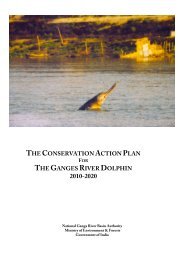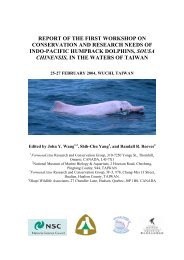catch in fisheries should be addressed urgently,through research, m<strong>on</strong>itoring, <strong>and</strong> management.2.2.2 Steno bredanensisDistributi<strong>on</strong>No new informati<strong>on</strong>.Populati<strong>on</strong>/stock structureNo new informati<strong>on</strong>.sampling should be attempted in areas where thisspecies is seen <strong>on</strong> a regular basis, such as <str<strong>on</strong>g>the</str<strong>on</strong>g>Babuyan Isl<strong>and</strong>s. <strong>The</strong>re is a need for assessment<str<strong>on</strong>g>of</str<strong>on</strong>g> <str<strong>on</strong>g>the</str<strong>on</strong>g> effects <str<strong>on</strong>g>of</str<strong>on</strong>g> by-catch in l<strong>on</strong>gline fisheries,especially for waters between <str<strong>on</strong>g>the</str<strong>on</strong>g> Philippines<strong>and</strong> Taiwan. In light <str<strong>on</strong>g>of</str<strong>on</strong>g> <str<strong>on</strong>g>the</str<strong>on</strong>g> paucity <str<strong>on</strong>g>of</str<strong>on</strong>g> specimenmaterial for <str<strong>on</strong>g>the</str<strong>on</strong>g> regi<strong>on</strong>, samples (skulls <strong>and</strong> genetictissues) should be collected whenever possible.2.2.3 Sousa chinensisPopulati<strong>on</strong> statusNo new informati<strong>on</strong>.Habitat statusNo new informati<strong>on</strong>.Directed catchesSpecimens thought to have been harpo<strong>on</strong>ed havebeen found in Taiwan fishing ports (Doc. 6). <strong>The</strong>specimen from <str<strong>on</strong>g>the</str<strong>on</strong>g> Philippines menti<strong>on</strong>ed in <str<strong>on</strong>g>the</str<strong>on</strong>g>1995 workshop report may have been taken in apurse seine. Stocks in SE Asia may be affected by<str<strong>on</strong>g>the</str<strong>on</strong>g> infrequent drive-fishery catches in Japanesewaters.By-catchesBy-catch occurs <strong>on</strong> l<strong>on</strong>glines <strong>and</strong> in drift gillnetsin Taiwanese waters (Doc. 6). This specieshas a tendency to be associated with logs <strong>and</strong>o<str<strong>on</strong>g>the</str<strong>on</strong>g>r floating objects, <strong>and</strong> it may <str<strong>on</strong>g>the</str<strong>on</strong>g>refore bepredisposed to capture in l<strong>on</strong>gline <strong>and</strong> purse seinefisheries. In <str<strong>on</strong>g>the</str<strong>on</strong>g> Babuyan Isl<strong>and</strong>s, Philippines,some by-catch may occur <strong>on</strong> l<strong>on</strong>glines. Twostr<strong>and</strong>ed specimens from Vietnam had evidence<str<strong>on</strong>g>of</str<strong>on</strong>g> gillnet markings, <strong>and</strong> were probably by-caught(Doc. 4).Needs for additi<strong>on</strong>al researchNo directed research <strong>on</strong> this species has beenc<strong>on</strong>ducted anywhere in SE Asia. Such studieswould be beneficial, especially in areas <str<strong>on</strong>g>of</str<strong>on</strong>g> highfishing effort in deep water. Opportunistic biopsyDistributi<strong>on</strong><strong>The</strong> distributi<strong>on</strong> <str<strong>on</strong>g>of</str<strong>on</strong>g> <str<strong>on</strong>g>the</str<strong>on</strong>g> Indo-Pacific humpbackdolphin is fragmented in many areas. Wang <strong>and</strong>Hung reported that <str<strong>on</strong>g>the</str<strong>on</strong>g> distributi<strong>on</strong> in Chinesewaters has recently been shown to extend to <str<strong>on</strong>g>the</str<strong>on</strong>g>west coast <str<strong>on</strong>g>of</str<strong>on</strong>g> <str<strong>on</strong>g>the</str<strong>on</strong>g> main isl<strong>and</strong> <str<strong>on</strong>g>of</str<strong>on</strong>g> Taiwan. Verifiablerecords from <str<strong>on</strong>g>the</str<strong>on</strong>g> coast <str<strong>on</strong>g>of</str<strong>on</strong>g> China suggest that eightor nine populati<strong>on</strong>s <str<strong>on</strong>g>of</str<strong>on</strong>g> humpback dolphins mayexist from <str<strong>on</strong>g>the</str<strong>on</strong>g> Vietnam border to <str<strong>on</strong>g>the</str<strong>on</strong>g> mouth <str<strong>on</strong>g>of</str<strong>on</strong>g> <str<strong>on</strong>g>the</str<strong>on</strong>g>Yangzi River, mostly centered around <str<strong>on</strong>g>the</str<strong>on</strong>g> mouths<str<strong>on</strong>g>of</str<strong>on</strong>g> large rivers (Jeffers<strong>on</strong> 2000b). Humpbackdolphins appear to be comm<strong>on</strong> in <str<strong>on</strong>g>the</str<strong>on</strong>g> H<strong>on</strong>Tre River area (Doc. 3). Dolar reported anunc<strong>on</strong>firmed str<strong>and</strong>ing in <str<strong>on</strong>g>the</str<strong>on</strong>g> Turtle Isl<strong>and</strong>s area<str<strong>on</strong>g>of</str<strong>on</strong>g> <str<strong>on</strong>g>the</str<strong>on</strong>g> Philippines. [Editors’ note: <str<strong>on</strong>g>the</str<strong>on</strong>g> specimenhas now been c<strong>on</strong>firmed to be an Indo-Pacifichumpback dolphin]. <strong>The</strong> species has now beenc<strong>on</strong>firmed from Cambodian waters (Doc. 34).Populati<strong>on</strong>/stock structure<strong>The</strong> tax<strong>on</strong>omy <str<strong>on</strong>g>of</str<strong>on</strong>g> <str<strong>on</strong>g>the</str<strong>on</strong>g> genus Sousa remainsc<strong>on</strong>fused in spite <str<strong>on</strong>g>of</str<strong>on</strong>g> c<strong>on</strong>siderable recent research(IWC in press). Although West African humpbackdolphins (Sousa teuszii) clearly c<strong>on</strong>stitute aseparate species, <str<strong>on</strong>g>the</str<strong>on</strong>g> tax<strong>on</strong>omy <str<strong>on</strong>g>of</str<strong>on</strong>g> animals in <str<strong>on</strong>g>the</str<strong>on</strong>g>Indo-Pacific must await <str<strong>on</strong>g>the</str<strong>on</strong>g> completi<strong>on</strong> <str<strong>on</strong>g>of</str<strong>on</strong>g> <strong>on</strong>goingstudies using molecular genetic <strong>and</strong> morphometrictechniques. Some preliminary evidence suggeststhat eastern (chinensis-type) <strong>and</strong> western IndianOcean (plumbea-type) forms may be distinct(Jeffers<strong>on</strong> 2000c). At this point, though, it isprudent to provisi<strong>on</strong>ally recognize <strong>on</strong>ly <strong>on</strong>e<str<strong>on</strong>g>Sec<strong>on</strong>d</str<strong>on</strong>g> <str<strong>on</strong>g>Workshop</str<strong>on</strong>g> <strong>on</strong> <str<strong>on</strong>g>the</str<strong>on</strong>g> <strong>Biology</strong> <strong>and</strong> C<strong>on</strong>servati<strong>on</strong> <str<strong>on</strong>g>of</str<strong>on</strong>g> Small Cetaceans <strong>and</strong> Dug<strong>on</strong>gs <str<strong>on</strong>g>of</str<strong>on</strong>g> SE Asia 69
species in <str<strong>on</strong>g>the</str<strong>on</strong>g> Indo-Pacific (S. chinensis). A newspecies, Sousa huangi, described from China (P.-L.Wang 1999) is thought to be based <strong>on</strong> a juvenilespecimen <str<strong>on</strong>g>of</str<strong>on</strong>g> S. chinensis.Populati<strong>on</strong> status<strong>The</strong> statement in <str<strong>on</strong>g>the</str<strong>on</strong>g> 1995 workshop reportthat <str<strong>on</strong>g>the</str<strong>on</strong>g> H<strong>on</strong>g K<strong>on</strong>g populati<strong>on</strong> <str<strong>on</strong>g>of</str<strong>on</strong>g> humpbackdolphins numbered <strong>on</strong>ly about 84 individualswas inaccurate. Jeffers<strong>on</strong> reported that extensivevessel-based survey work has shown that <str<strong>on</strong>g>the</str<strong>on</strong>g> H<strong>on</strong>gK<strong>on</strong>g <strong>and</strong> Pearl River Estuary populati<strong>on</strong> is muchlarger than previously believed, numbering atleast 1,383 animals. Despite <str<strong>on</strong>g>the</str<strong>on</strong>g> many threats stillfacing this populati<strong>on</strong>, Jeffers<strong>on</strong> (2000b) believes itto still be viable. About 60-80 animals occur in <str<strong>on</strong>g>the</str<strong>on</strong>g>Xiamen area (Doc. 9).Habitat statusHabitat degradati<strong>on</strong> is rampant in many areas<str<strong>on</strong>g>of</str<strong>on</strong>g> <str<strong>on</strong>g>the</str<strong>on</strong>g> species’ range, including well-studiedregi<strong>on</strong>s such as H<strong>on</strong>g K<strong>on</strong>g <strong>and</strong> Xiamen, P.R.China. Plans to c<strong>on</strong>serve <str<strong>on</strong>g>the</str<strong>on</strong>g> dolphin populati<strong>on</strong>sare in place for both <str<strong>on</strong>g>of</str<strong>on</strong>g> <str<strong>on</strong>g>the</str<strong>on</strong>g>se areas. In H<strong>on</strong>gK<strong>on</strong>g, <str<strong>on</strong>g>the</str<strong>on</strong>g>se include l<strong>on</strong>g-term research <strong>and</strong>m<strong>on</strong>itoring <str<strong>on</strong>g>of</str<strong>on</strong>g> <str<strong>on</strong>g>the</str<strong>on</strong>g> populati<strong>on</strong>, <str<strong>on</strong>g>the</str<strong>on</strong>g> creati<strong>on</strong> <str<strong>on</strong>g>of</str<strong>on</strong>g>marine reserves for protecti<strong>on</strong> <str<strong>on</strong>g>of</str<strong>on</strong>g> <str<strong>on</strong>g>the</str<strong>on</strong>g> species,development <str<strong>on</strong>g>of</str<strong>on</strong>g> a c<strong>on</strong>servati<strong>on</strong> plan, <strong>and</strong> <str<strong>on</strong>g>the</str<strong>on</strong>g>requirement <str<strong>on</strong>g>of</str<strong>on</strong>g> mitigati<strong>on</strong> measures for marinec<strong>on</strong>structi<strong>on</strong> <strong>and</strong> development activities (Doc.18,21). <strong>The</strong> flow <str<strong>on</strong>g>of</str<strong>on</strong>g> all major rivers <str<strong>on</strong>g>of</str<strong>on</strong>g> <str<strong>on</strong>g>the</str<strong>on</strong>g> westcoast <str<strong>on</strong>g>of</str<strong>on</strong>g> Taiwan have been greatly reduced by <str<strong>on</strong>g>the</str<strong>on</strong>g>c<strong>on</strong>structi<strong>on</strong> <str<strong>on</strong>g>of</str<strong>on</strong>g> dams <strong>and</strong> reservoirs, <str<strong>on</strong>g>the</str<strong>on</strong>g> bankshave been altered by flood-c<strong>on</strong>trol measures, an<str<strong>on</strong>g>the</str<strong>on</strong>g> estuaries are badly degraded. Estuaries al<strong>on</strong>g<str<strong>on</strong>g>the</str<strong>on</strong>g> west coast <str<strong>on</strong>g>of</str<strong>on</strong>g> Taiwan are badly degraded, asare several areas al<strong>on</strong>g <str<strong>on</strong>g>the</str<strong>on</strong>g> mainl<strong>and</strong> Chinesecoast (Doc. 9). In additi<strong>on</strong>, fishing activities are<str<strong>on</strong>g>of</str<strong>on</strong>g>ten more intense in <str<strong>on</strong>g>the</str<strong>on</strong>g> productive estuarineareas typically inhabited by humpback dolphinsthan elsewhere.Directed catchesNo directed fisheries for this species are known,apart from <str<strong>on</strong>g>the</str<strong>on</strong>g> fact that 12 humpback dolphinswere recently live-captured for display at a casinoin Cambodia (Doc. 34). Data <strong>on</strong> <str<strong>on</strong>g>the</str<strong>on</strong>g> number <str<strong>on</strong>g>of</str<strong>on</strong>g>animals live-captured in <str<strong>on</strong>g>the</str<strong>on</strong>g> Gulf <str<strong>on</strong>g>of</str<strong>on</strong>g> Thail<strong>and</strong>were not available to this meeting. <str<strong>on</strong>g>Workshop</str<strong>on</strong>g>participants c<strong>on</strong>sidered that although <str<strong>on</strong>g>the</str<strong>on</strong>g> numbertaken since <str<strong>on</strong>g>the</str<strong>on</strong>g> start <str<strong>on</strong>g>of</str<strong>on</strong>g> live-capture operati<strong>on</strong>s in<str<strong>on</strong>g>the</str<strong>on</strong>g> Gulf <str<strong>on</strong>g>of</str<strong>on</strong>g> Thail<strong>and</strong> is not known accurately, it mayhave been great enough to affect <str<strong>on</strong>g>the</str<strong>on</strong>g> wild sourcepopulati<strong>on</strong>(s). In 1960-1962, 36 humpback dolphinswere deliberately killed by netting in Xiamen, P.R.China, in an attempt to reduce fishing interference<strong>and</strong> to test <str<strong>on</strong>g>the</str<strong>on</strong>g> feasibility <str<strong>on</strong>g>of</str<strong>on</strong>g> using <str<strong>on</strong>g>the</str<strong>on</strong>g>ir skin as asource <str<strong>on</strong>g>of</str<strong>on</strong>g> lea<str<strong>on</strong>g>the</str<strong>on</strong>g>r (Wang 1965).By-catchesBy-catches have been documented in almost everyarea where this species has been studied in <str<strong>on</strong>g>the</str<strong>on</strong>g>regi<strong>on</strong>. <strong>The</strong>y most <str<strong>on</strong>g>of</str<strong>on</strong>g>ten involve set gillnet, driftnet<strong>and</strong> trawl fisheries. Wang reported that some liveanimals recently observed <str<strong>on</strong>g>of</str<strong>on</strong>g>f Taiwan had large scars<strong>on</strong> <str<strong>on</strong>g>the</str<strong>on</strong>g>ir caudal peduncles that were c<strong>on</strong>sistent withinjuries caused by net fisheries. Although <str<strong>on</strong>g>the</str<strong>on</strong>g>reare records <str<strong>on</strong>g>of</str<strong>on</strong>g> by-catch in mainl<strong>and</strong> China, <str<strong>on</strong>g>the</str<strong>on</strong>g> lack<str<strong>on</strong>g>of</str<strong>on</strong>g> more extensive data <strong>on</strong> by-catch <str<strong>on</strong>g>the</str<strong>on</strong>g>re may bedue, at least in part, to <str<strong>on</strong>g>the</str<strong>on</strong>g> species’ protected status(Grade 1), which makes fishermen reluctant todisclose incidental catches (Doc. 9). One str<strong>and</strong>ing<strong>on</strong> Taiwan’s Chinmen Isl<strong>and</strong> may have been <str<strong>on</strong>g>the</str<strong>on</strong>g>result <str<strong>on</strong>g>of</str<strong>on</strong>g> capture in a fish trap. Torey (Doc. 7)summarized six cases <str<strong>on</strong>g>of</str<strong>on</strong>g> certain or possible netentanglement in H<strong>on</strong>g K<strong>on</strong>g waters between 1975<strong>and</strong> 2000. She also reported that an <strong>on</strong>-boardfishery observer program was about to begin inH<strong>on</strong>g K<strong>on</strong>g, <strong>and</strong> <str<strong>on</strong>g>the</str<strong>on</strong>g>refore better data may beavailable in <str<strong>on</strong>g>the</str<strong>on</strong>g> near future. Humpback dolphinsare taken in inshore gillnets al<strong>on</strong>g <str<strong>on</strong>g>the</str<strong>on</strong>g> nor<str<strong>on</strong>g>the</str<strong>on</strong>g>rncoast <str<strong>on</strong>g>of</str<strong>on</strong>g> Australia (Doc. 16).70 CMS Technical Series Publicati<strong>on</strong> Nº 9 - 2005
- Page 1 and 2:
CMS Technical Series Publication N
- Page 3 and 4:
Published by the U
- Page 5 and 6:
TABLE OF CONTENTSpage1. Preliminari
- Page 7 and 8:
AppendicesAppendix 1 - List <strong
- Page 9 and 10:
8 CMS Technical Series Publication
- Page 11 and 12:
10 CMS Technical Series Publication
- Page 13 and 14:
The cetacean species reviewed inclu
- Page 15 and 16:
Table 1. Major commercial Commonwea
- Page 17 and 18:
(2) State Legislation.In state wate
- Page 19 and 20: (2) Identification of</stro
- Page 21 and 22: Coastal speciesThe most frequently
- Page 23 and 24: Coastal speciesThere are currently
- Page 25 and 26: and Guangxi Provinces (Yang et al.
- Page 27 and 28: Table 3. Records of</strong
- Page 29 and 30: can be viewed as the</stron
- Page 31 and 32: Workshop participa
- Page 33 and 34: ioaccumulation have not yet been ex
- Page 35 and 36: of fishermen who h
- Page 37 and 38: are supplied to scholars and organi
- Page 39 and 40: threats. Many marine mammal populat
- Page 42: waters or recognize important inter
- Page 47 and 48: James Cook University (Queensland,
- Page 49 and 50: the last ten years
- Page 51 and 52: proactive in engaging more staff an
- Page 53 and 54: of SE Asia. Two sp
- Page 55 and 56: San Francisco (Negros Oriental); Li
- Page 57 and 58: Legal status and present management
- Page 59 and 60: within 15 kilometers from t
- Page 61 and 62: US, has actively participated in ce
- Page 63 and 64: the project was su
- Page 65 and 66: Recently, the camp
- Page 67 and 68: Mekong River downstream of<
- Page 69: porpoises in tropical waters <stron
- Page 73 and 74: Population/stock structureNo new in
- Page 75 and 76: Needs for additional researchStock
- Page 77 and 78: waters of SE Asia,
- Page 79 and 80: caused mortality is certainly large
- Page 81 and 82: Needs for additional researchProper
- Page 83 and 84: from SE Asia, it is known to occur
- Page 85 and 86: 3.1.7 AustraliaDugongs occur all al
- Page 87 and 88: Table 8. Conservation objectives id
- Page 89 and 90: 3) Monitoring and assessment <stron
- Page 91 and 92: Table 10. Outline of</stron
- Page 93 and 94: The group agreed that this set <str
- Page 95 and 96: 6. SUMMARY AND CONCLUSIONSThe works
- Page 97 and 98: 96 CMS Technical Series Publication
- Page 99 and 100: Bank, E. 1931. A popular account <s
- Page 101 and 102: Dalebout, M. L., J. G. Mead, C. Sco
- Page 103 and 104: Jaaman, S. A., E. Tangon, I. Isnain
- Page 105 and 106: Lin, Y.-J. 1997. Mitochondrial DNA
- Page 107 and 108: Smith, B.D., T. A. Jefferson, D. Ho
- Page 109 and 110: Yang, W.-C. 2000. Morbillivirus inf
- Page 111 and 112: CHOU Lien-SiangDepartment o
- Page 113 and 114: Brian D. SMITHWildlife Conservation
- Page 115 and 116: APPENDIX 3Agenda1. Preliminaries2.
- Page 117 and 118: Doc. 22 Dugong conservation activit
- Page 119 and 120: AreaDatesSurveyTypeEffortSpeciesNo.
- Page 121 and 122:
AreaDatesSurveyTypeEffortSpeciesNo.
- Page 123 and 124:
AreaDatesSurveyTypeEffortSpeciesNo.
- Page 125 and 126:
Phase ofActionPlan
- Page 127 and 128:
[Small cetaceans are defined to inc
- Page 129 and 130:
f) recognizing that by-catch in fis
- Page 131 and 132:
130 CMS Technical Series Publicatio
- Page 133 and 134:
APPENDIX 9Abstracts of</str
- Page 135 and 136:
The (IUCN Critically Endangered) Du
- Page 137 and 138:
Status of
- Page 139 and 140:
Cetacean Habitats in the</s
- Page 141 and 142:
Conservation of <s
- Page 143 and 144:
Summary of Current
- Page 145 and 146:
Indonesia’s Cetacean Migration Co
- Page 147 and 148:
Conservation Effort to Protect <str
- Page 149 and 150:
The Status of <str
- Page 151 and 152:
Can the Developing
- Page 153 and 154:
Status and Conservation of<
- Page 155 and 156:
Legal Hunting of C
- Page 157 and 158:
Indo-Pacific Bottlenose Dolphins (T
- Page 159 and 160:
Feasibility Study of</stron
- Page 161 and 162:
Songs of a Humpbac





